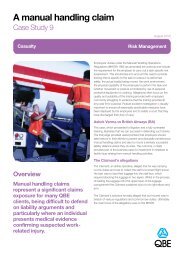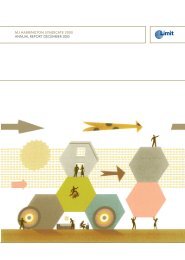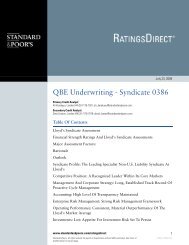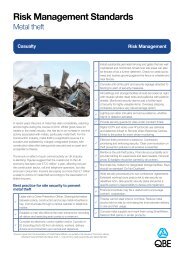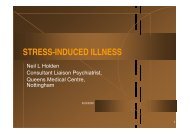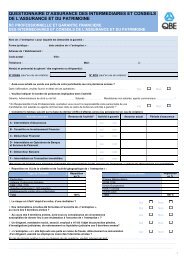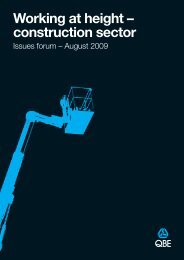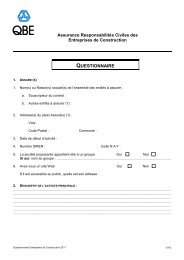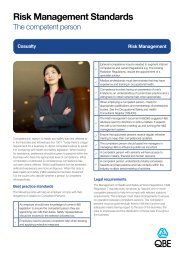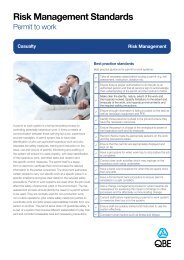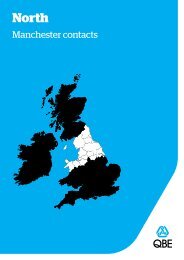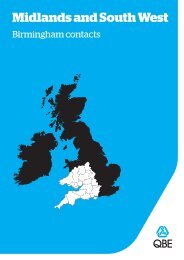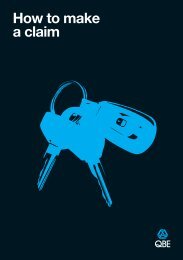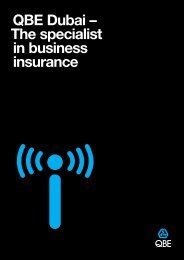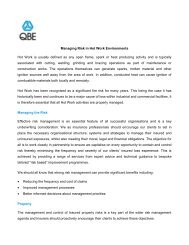QBE European Operations plc
QBE European Operations plc
QBE European Operations plc
You also want an ePaper? Increase the reach of your titles
YUMPU automatically turns print PDFs into web optimized ePapers that Google loves.
<strong>QBE</strong> <strong>European</strong> <strong>Operations</strong> <strong>plc</strong> Annual report 2011<br />
51<br />
1 Accounting policies continued<br />
and unexpired risks provision. The expected claims are calculated having<br />
regard to events that have occurred prior to the balance sheet date.<br />
Unexpired risk surpluses and deficits are offset where business classes<br />
are managed together.<br />
vii) Equalisation provision<br />
Amounts are set aside as equalisation provisions in accordance with<br />
the Financial Services Authority Handbook for the purpose of mitigating<br />
exceptionally high loss ratios in future years. The amounts provided are<br />
not liabilities because they are in addition to the provisions required to<br />
meet the anticipated ultimate cost of settlement of outstanding claims<br />
at the balance sheet date. Notwithstanding this, they are required by<br />
Schedule 3 to SI 2008/410 to be included within technical provisions.<br />
viii) Reinsurance to close (RITC)<br />
Following the end of the third year, the underwriting account of each<br />
Lloyd’s syndicate is normally closed by reinsurance into the following<br />
year of account. The amount of the RITC premium is determined by the<br />
managing agent, generally by estimating the cost of claims notified but<br />
not settled together with the estimated cost of claims incurred but not<br />
reported at that date and claims handling costs.<br />
fair values of Group’s share of the net identifiable assets acquired and is<br />
capitalised in the balance sheet at cost and amortised through the profit<br />
and loss account over 20 years. Carrying values are reviewed regularly<br />
for signs of impairment. The gain or loss on any subsequent disposal<br />
of subsidiary or associated undertakings will include any attributable<br />
unamortised goodwill.<br />
Other goodwill relates to the discounting of technical provisions<br />
arising from the fair value exercise carried out following acquisitions.<br />
Its amortisation period is based on the class of business, the historic<br />
settlement rate and the consideration of whether the historic settlement<br />
pattern would be appropriate into the future. The settlement period was<br />
estimated by modelling the settlement patterns of the underlying claims<br />
and related reinsurance recoveries.<br />
The cost of purchased syndicate participation is amortised over 20 years<br />
from the start of the first underwriting year, being management’s best<br />
estimate of its useful economic life.<br />
The cost of renewal rights are written off over five years and other<br />
intangible assets over ten years, from the acquisition date, being<br />
management’s best estimate of their useful economic life.<br />
To the extent that the Group has increased or decreased its participation<br />
in a syndicate from one year of account to the next, the RITC paid is<br />
treated as a portfolio transfer from the closing year to the receiving year.<br />
The share of the RITC receivable is recognised as income in the period<br />
that the RITC contract is concluded, together with related claims incurred<br />
under the contract.<br />
The payment of an RITC premium does not eliminate the liability of the<br />
closed year for outstanding claims. If the reinsuring syndicate was unable<br />
to meet its obligations and other elements of Lloyd’s chain of security<br />
were to fail, then the closed underwriting account would have to settle the<br />
outstanding claims. The directors consider that the likelihood of such a<br />
failure of the RITC is remote and consequently the RITC has been deemed<br />
to settle liabilities outstanding at the closure of an underwriting account.<br />
ix) Outwards reinsurance<br />
Outwards reinsurance premiums written relate to business ceded during<br />
the year, including an estimate of any adjustment premiums payable,<br />
together with any differences between estimates in the prior years and<br />
that actually ceded. Outwards premiums are recognised as earned over<br />
the period of the policy having regard to the incidence of risk. Policies<br />
that respond with reference to the attachment point are earned in line<br />
with the related inwards written premiums. Policies that respond in<br />
relation to the date of loss are earned on a time apportionment basis<br />
unless there is a marked unevenness in the incidence of risk over<br />
the period of cover, when a basis which reflects the profile of risk is<br />
used. The unexpired proportion of the outwards premiums at the<br />
balance sheet date is carried forward as reinsurers’ share of unearned<br />
premiums provision.<br />
Amortisation of other goodwill is included in other technical charges in<br />
the technical account. Amortisation of other intangible assets is included<br />
in other charges in the non-technical account.<br />
g) Tangible assets<br />
Tangible assets are stated at cost less depreciation, with the exception<br />
of owner occupied property which is stated at its revalued amount.<br />
Cost includes the original purchase price of the asset and the costs<br />
attributable to bringing the asset to its working condition for its intended<br />
use. Depreciation is provided at rates calculated to write off the cost<br />
less estimated residual value in equal amounts over the estimated useful<br />
lives of the tangible assets. No depreciation is provided on assets under<br />
construction. Each asset’s estimated useful life, residual value and<br />
method of depreciation are reviewed and adjusted if appropriate at<br />
each year end.<br />
The estimated lives are as follows:<br />
Office equipment<br />
Computer equipment<br />
Motor vehicles<br />
Leasehold improvements<br />
from three to ten years<br />
from three to ten years<br />
five years<br />
life of lease<br />
A review for impairment of a tangible asset is carried out if events or<br />
changes in circumstances indicate that the carrying amount of the<br />
tangible asset may not be recoverable. The recoverable amount is the<br />
higher of its fair value less costs to sell and its value in use. If the carrying<br />
value exceeds the recoverable amount the carrying value is reduced<br />
by writing the difference to the profit and loss account in that period.<br />
Financial statements<br />
e) Expenses<br />
Acquisition costs, general overheads and other expenses are charged<br />
as incurred to the profit and loss technical account, net of the change<br />
in deferred acquisition costs. Investment expenses are charged to the<br />
profit and loss non-technical account.<br />
f) Intangible assets<br />
Goodwill represents the excess of the cost of an acquisition over the<br />
Investment properties included in land and buildings are valued at open<br />
market valuation. Full valuations are made by independent, professional<br />
qualified valuers every year. The aggregate surplus or deficit on<br />
revaluation is taken to the non-technical account.<br />
In accordance with SSAP 19, no depreciation is provided in respect of<br />
freehold investment properties and leasehold investment properties with<br />
over 20 years to run. The requirement of the Companies Act 2006 is to



